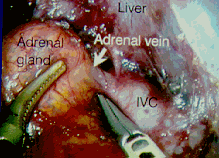Cepat betul masa berlalu. Tup2, dah 5 minggu berattachment di Galway. Dah selesai neurology and cardiology attachment. Sekarang tengah buat general surgery dengan Mr. Mc Anena. Hish....scary gak consultant ni. Sehari mood dia ok, sehari lepas tu, dia moody pulak. Adehh...aku pun terkena tempias..hehe (melawak je). Apapun, lagi 3 minggu balik malaysia, insya Allah...=)
Yesterday, whole day in theatre. Menarik dan best..tapi penat berdiri. There's one patient with left adrenal mass and adrenalectomy was performed by Mr. Mc Anena. I've already talk to the patient early this week and I think this case is interesting because the only sign is hypertension. The mass was accidentally detected during MRI.
Yesterday, whole day in theatre. Menarik dan best..tapi penat berdiri. There's one patient with left adrenal mass and adrenalectomy was performed by Mr. Mc Anena. I've already talk to the patient early this week and I think this case is interesting because the only sign is hypertension. The mass was accidentally detected during MRI.
PHEOCHROMOCYTOMA
Background:
Pheochromocytoma is a rare catecholamine-secreting tumor derived from chromaffin cells. Tumors that arise outside the adrenal gland are termed extra-adrenal pheochromocytomas or paragangliomas. Because of excessive catecholamine secretion, pheochromocytomas may precipitate life-threatening hypertension or cardiac arrhythmias. If the diagnosis of a pheochromocytoma is overlooked, the consequences could be disastrous, even fatal; however, if a pheochromocytoma is found, it is potentially curable.
Pheochromocytoma may occur as a single tumor or as multiple growths. It usually develops in the medulla (center or core) of one or both adrenal glands. Sometimes this kind of tumor occurs outside the adrenal gland, usually somewhere else in the abdomen. Less than 10% of pheochromocytomas are malignant (cancerous), with the potential to spread to other parts of the body. The tumors may occur at any age, but they are most common from early to mid-adulthood.
Pheochromocytoma may occur as a single tumor or as multiple growths. It usually develops in the medulla (center or core) of one or both adrenal glands. Sometimes this kind of tumor occurs outside the adrenal gland, usually somewhere else in the abdomen. Less than 10% of pheochromocytomas are malignant (cancerous), with the potential to spread to other parts of the body. The tumors may occur at any age, but they are most common from early to mid-adulthood.

Pathophysiology:
The clinical manifestations of a pheochromocytoma result from excessive catecholamine secretion by the tumor. Catecholamines typically secreted, either intermittently or continuously, include norepinephrine and epinephrine and rarely dopamine. The biological effects of catecholamines are well known. Stimulation of alpha-adrenergic receptors results in elevated blood pressure, increased cardiac contractility, glycogenolysis, gluconeogenesis, and intestinal relaxation. Stimulation of beta-adrenergic receptors results in an increase in heart rate and contractility.
Catecholamine secretion in pheochromocytomas is not regulated in the same manner as in healthy adrenal tissue. Unlike the healthy adrenal medulla, pheochromocytomas are not innervated, and catecholamine release is not precipitated by neural stimulation. The trigger for catecholamine release is unclear, but multiple mechanisms have been postulated, including direct pressure, medications, and changes in tumor blood flow.
Catecholamine secretion in pheochromocytomas is not regulated in the same manner as in healthy adrenal tissue. Unlike the healthy adrenal medulla, pheochromocytomas are not innervated, and catecholamine release is not precipitated by neural stimulation. The trigger for catecholamine release is unclear, but multiple mechanisms have been postulated, including direct pressure, medications, and changes in tumor blood flow.
Symptoms:
# Headache
# Diaphoresis
# Palpitations
# Tremor
# Nausea
# Weakness
# Anxiety, sense of doom
# Epigastric pain
# Flank pain
# Constipation
# Weight loss
Clinical signs:
* Hypertension (paroxysmal in 50% of cases)
* Postural hypotension: This results from volume contraction.
* Hypertensive retinopathy
* Weight loss
* Pallor
* Fever
* Tremor
* Neurofibromas
* Café au lait spots: These are patches of cutaneous pigmentation, which vary from 1-10 mm and occur any place on the body. Characteristic locations include the axillae and intertriginous areas (groin). They vary from light to dark brown, hence the name café au lait.
* Tachyarrhythmias
* Pulmonary edema
* Cardiomyopathy
* Ileus
Tests include:

* Adrenal biopsy can show pheochromocytoma.
* MIBG scintiscan can show a tumor.
* MRI of abdomen can show a adrenal mass.
* Abdominal CT scan can show a mass.
* Urine metanephrine will be high.
* Urine catecholamines will be high.
* Glucose test results will be abnormal.
* Catecholamines in the blood will be abnormal.
Treatment:
The definitive treatment is removal of the tumor by surgery. Stabilization of the person's vital signs with medication prior to surgery is important, and may require hospitalization. After surgery, it is necessary to continually monitor all vital signs in an intensive care unit. In the case of an inoperable tumor, management with medication is necessary. Radiation therapy or chemotherapy have not been effective in curing this kind of tumor.


No comments:
Post a Comment